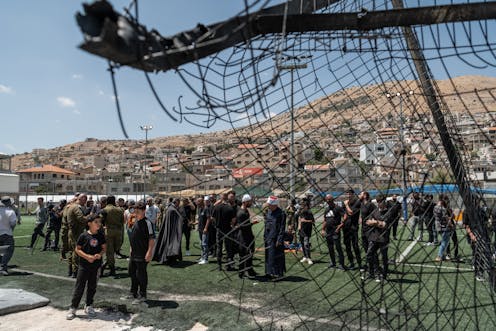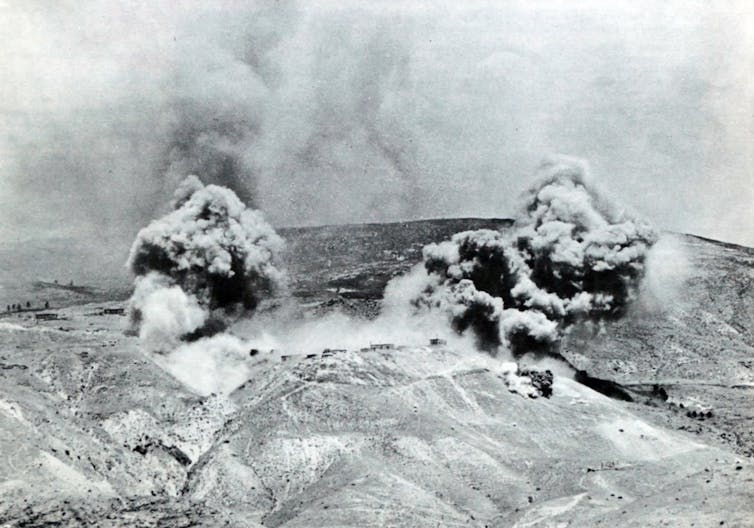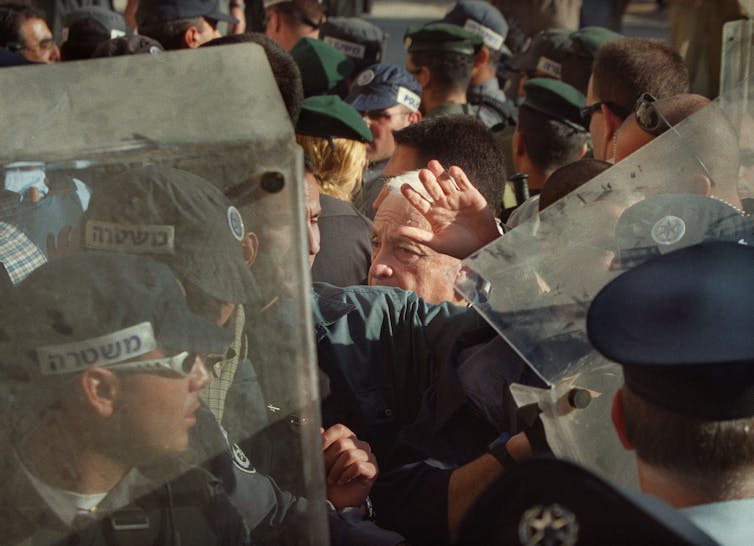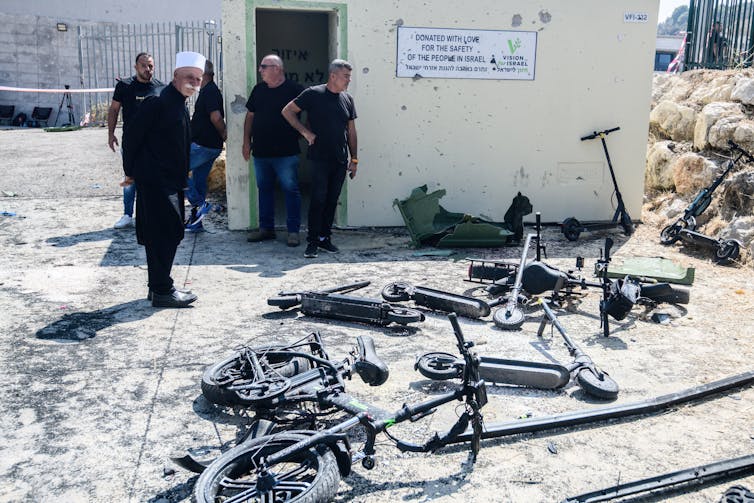Deadly strike in the Golan Heights risks opening new front in long-disputed territory
12 children were killed in a strike on the small town of Majdal Shams, in the Israeli-occupied Golan Heights. Israel has blamed Hezbollah, but the Lebanese militant group denies responsibility.

A missile strike that killed 12 children playing soccer in the Israeli-occupied Golan Heights on July 27, 2024, has prompted international concern that the Middle East conflict could expand into the disputed territory.
Israel has blamed the Lebanese militant group Hezbollah, and it has already conducted retaliatory strikes, with more expected.
To explain the importance of the Golan Heights and what the latest strike could indicate, The Conversation turned to Mireille Rebeiz, a scholar of Lebanese studies and chair of Middle East Studies at Dickinson College.
What is the Golan Heights?
Located in southwestern Syria, the Golan Heights is 1,200 square kilometers (460 square miles) of mainly stony hills that overlook Syria, Lebanon and Jordan.
Today, over 40,000 people live there. More than half are Arab Druze, including the community in the small town of Majdal Shams – the site of the recent attack. Many of them identify as Syrian citizens and refuse to accept Israeli citizenship. The rest are Jewish settlers, most of whom arrived in the territory after it was occupied by Israel more than half a century ago.
Can you walk us through the history of this occupation?
In June 1967, after the Six-Day War between Israel and three of its Arab neighbors – Syria, Egypt and Jordan – the Golan Heights fell under Israeli occupation, along with East Jerusalem, the West Bank, the Gaza Strip and the Sinai Peninsula.
This prompted the United Nations Security Council to adopt Resolution 242, which called for Israel’s withdrawal from all of those occupied territories. It also called for the “termination of all claims and states of belligerency and respect for and acknowledgment of the sovereignty, territorial integrity and political independence of every State in the area and their right to live in peace within secure and recognized boundaries free from threats or acts of force.”

In 1973, Syrian forces reconquered the Golan Heights in a surprise attack, before Israel’s counterattack reclaimed it. Israel withdrew from some Syrian territories. However, it refused to return the Golan Heights and insisted it would do so only after the signing of a peace treaty with Syria.
A year later, Syria and Israel signed an armistice agreement, in which both countries agreed to a cease-fire and for a United Nations observer to be put in place to maintain the cease-fire.
On Dec. 14, 1981, eight years after signing the armistice agreement, the Israeli Knesset adopted the Golan Heights Law, which extended Israeli jurisdiction to the region. In other words, it annexed the Golan Heights.
The United Nations Security Council responded by unanimously adopting Resolution 497. It declared the imposition of Israeli law over the Golan Heights illegal and called on Israel to rescind its decision.
What is the current status of the Golan Heights?
Under international law, the annexation of the territory remains illegal. As such, the Golan Heights remains occupied territory, regardless of the Israeli law.
There have been some attempts to negotiate a resolution. In 2000, Israeli, Syrian and U.S. delegations met in West Virginia to that end. However, the talks never went anywhere.
Since then, the status of the Golan Heights has been put on the back burner, as events elsewhere in the region have demanded more attention: First, a provocative visit of former Israeli Prime Minister Ariel Sharon to Al-Aqsa Mosque in Jerusalem in 2000 sparked Palestinian protests that became the Second Intifada, or uprising. It was followed in 2006 with a war between Hezbollah and Israel.

Then, on March 25, 2019, U.S. President Donald Trump signed a proclamation endorsing the annexation of the Golan Heights and recognizing it as Israeli territory. Echoing Israeli arguments, the proclamation noted that control of the Golan Heights was essential “to safeguard [Israel’s] security from external threats,” notably from “Iran and terrorist groups, including Hezbollah.”
If the Golan Heights is occupied Syrian territory, why is Lebanon involved?
Along with being an ally of Iran, Hezbollah has had a complicated but recently close relationship with Syrian President Bashar al-Assad, intervening in the country’s civil war on behalf of the Assad regime. As such, the Lebanese militants see themselves as allies of Syria in its dispute with Israel over the Golan Heights.
But complicating matters further, Lebanon and Hezbollah are involved in a long-running dispute that puts it them at odds with both Israel and Syria. It centers on an area located in the northern end of the Golan Heights called the Shebaa Farms.
Israel claims that the Shebaa Farms is part of the annexed Golan Heights. After appointing cartographers, the United Nations announced that the Shebaa Farms is in Syrian territory, and Assad asserted that the land was Syrian in 2011.
Despite these assertions, Hezbollah continues to claim that the Shebaa Farms area is Lebanese territory and that Lebanon has the right to resist the Israeli occupation there.
Why is the region seen as important?
The Golan Heights is seen as a crucial strategic outpost by Israel.
The elevated rocky plateau allows Israel to monitor Syrian activities and presumably push off any act of aggression from Syria or Iran, through Tehran-backed Hezbollah. Since occupying the territory, Israel has installed listening posts and military bases.
Meanwhile, the fertile land and other features of the Golan Heights makes it a valuable asset. It is known for its vineyards and other agriculture. And the territory has wide access to water through the Jordan River, the Yarmuk River and the Sea of Galilee. In fact, Israel has a chronic water shortage, using up the vast majority of its limited renewable water supply and drawing on additional water resources from occupied land.
Is an attack in the Golan Heights unusual?
Although the Golan Heights has often been caught in the crossfire between Israel and Hezbollah, this latest strike definitely represents an escalation in violence, and the fact that children were the victims makes it all the more shocking.
It should be noted that Hezbollah has been firing rockets into northern Israel in support of Gaza ever since the Israeli retaliatory strikes that followed the Oct. 7, 2023, attack by Hamas.

Israel and the United States have both accused Hezbollah of the July 27, 2024, attack on the Golan Heights. For its part, Hezbollah has denied any responsibility.
There are at least two ways to interpret this attack, if indeed Hezbollah was responsible. One possibility is that the militant group miscalculated the attention the strike would get from the international community. Although Hezbollah fighters have been engaged in near daily strikes in northern Israel, the group has – to date – appeared keen to not overstep the mark in a way that would invite a full-scale response from Israel or give reason for the U.S. to get further involved.
An alternative explanation is that Hezbollah deliberately attacked these children to send a message to Israel, one that suggests that Hezbollah is willing and able to start a war on a dormant front: the Golan Heights in Syria.
What are the implications of the attack?
The implications of a deliberate provocation by Iran-backed Hezbollah could be grave and risk widening the current conflict into a region-wide conflagration.
Eager to avoid such a scenario, the United States, France and other countries have called for an imminent de-escalation in the region.
Should these calls be ignored and Israeli military forces respond with force – provoking an escalation with Hezbollah – then I believe the consequences of the attack on Majdal Shams might be dire.
Since the Oct. 7 attack, more than 95,000 people have been displaced in southern Lebanon and 60,000 from northern Israel as a result of shelling by both sides.
If the intensity of the conflict and the level of force involved increase, the geographical focus might expand to include more villages and towns. And outside players like Iran might openly enter the war.
Such an escalation is in no one’s interest.
Mireille Rebeiz does not work for, consult, own shares in or receive funding from any company or organization that would benefit from this article, and has disclosed no relevant affiliations beyond their academic appointment.
Read These Next
West Antarctica’s history of rapid melting foretells sudden shifts in continent’s ‘catastrophic’ geo
A picture of what West Antarctica looked like when its ice sheet melted in the past can offer insight…
The celibate, dancing Shakers were once seen as a threat to society – 250 years later, they’re part
‘The Testament of Ann Lee,’ Mona Fastvold’s 2025 film, depicts part of the long history of Shaker…
From truce in the trenches to cocktails at the consulate: How Christmas diplomacy seeks to exploit s
World leaders like to talk up peace at Christmastime. But alongside the tales of seasonal breaks in…






